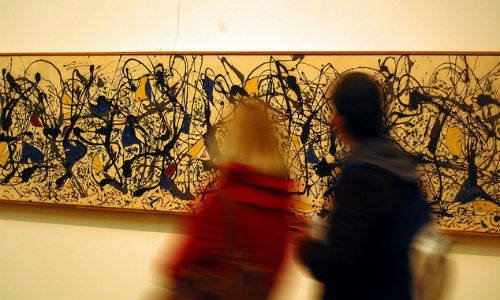Shock swept the art world last month when a 1982 painting by late graffiti artist and neo-expressionist Jean-Michel Basquiat sold at Sotheby’s for $110.5 million. It was the highest price ever paid at an auction for an American artist’s work.
It’s a good time to be a dead artist. And to be an art writer looking for a business angle.
Leave Manhattan
While it may seem that the bulk of art sales occur in metropolises with international cachet and concentrated wealth, focusing only on New York or London provides an incomplete view of the market and limits potential for stories. Today, for example, J. Levine, an auction house in Scottsdale, Arizona, will sell a previously unknown Jackson Pollock painting. Discovered in a local retirement community, the work is expected to fetch more than $10 million.
That’s a story in itself (especially considering that Pollock spent much of his youth on an Arizona farm), but a more insightful article might look at how this can alter the art conversation in Scottsdale. The city’s galleries are known for paintings of desert buttes and cowboys, not abstract expressionists. While $10 million is a drop in the bucket at a 300-year-old auction house like Sotheby’s, the Pollock will be J. Levine’s biggest ticket item to date. Could this draw more international attention to the Arizona art scene? Will it help form stronger bonds between the region and contemporary artists and collectors?
Choose your words with care
It goes without saying for any journalist, but using correct language is especially important for those covering artists who are frequently copied. Josh Levine, of J. Levine, told the Arizona Republic that he spent in excess of $50,000 on forensic reports and investigators to verify that the piece wasn’t a fake. Just as it’s important to be careful with words such as “alleged” and “charged” when covering police stories, journalists should also be careful when attributing paintings to artists. Even if the difference between a Rembrandt, a painting in the style of Rembrandt, and a painting attributed to Rembrandt is imperceptible, it makes all the difference to a buyer.
Examine the finances
Auction houses offer an abundance of financial details beyond the obvious. In terms of the lot itself, there is almost always a discrepancy between the appraised price and what it actually goes for. On a good day, that $10 million for the Pollock will be blown past without hesitation. There’s also the matter of the reserve price, a confidential minimum price agreed upon between the seller and the auction house. If nobody bids the minimum before time is up, the lot doesn’t sell. Savvy business reporters should examine why—and they should remember that the system is not set up for every lot at every auction to sell. After all, only so many people can afford to drop tens or hundreds of millions of dollars on a painting.
Moreover, the prices themselves are not directly related to the quality of the piece. The scarcity of the artist’s work, their mythos and the piece’s previous owners all have much more to do with the final bid.
Another interesting story might examine how the auction houses themselves make money. There isn’t one simple answer. One of the most common forms is commission. In other words, the auction house takes a small percentage, say around 4 percent, from the proceeds of the sale. So, the consigner gets the hammer price minus the commission. But not all houses charge a commission, as the bigger ones can rely on the buyer’s premium, which can range from a 2 percent up to even 25 percent. In other words, a buyer has to pay the hammer price plus a certain percentage to the auction house. Josh Levine, who will auction off today’s Pollock, wouldn’t disclose his commission but said as a rule the higher the price of the item, the less his commission.
Don’t forget the art
Business journalists are ultimately in the business of business. But they also need to inform readers about the work itself. Take the case of the Pollock, an expensive painting from a famous artist that has been out of the public and critical eye for several decades. A business reporter who wants to add depth to her story should focus on how this painting impacts Pollock’s reputation, his body of work and the work of his contemporaries. How does it impact the monetary value of other Pollocks? Interview an expert for a clear picture.
Reporter’s Takeaway
• There are smaller auction houses across the country, and the smaller they are, the bigger the chance of finding an easily localized story such as with Pollock and J. Levine. Most catalogs have some indication of the piece’s provenance—where it was found and who owned it—which gives a good indication of a background story.
• Art does not exist in a vacuum. Business journalists who want to appeal to a broader audience should look at the critical context, not just the financial one.
• Look outside the obvious story to see how a single piece or sale can impact the reputation of an auction house or change the art scene in the city in which it’s sold.
• Familiarize yourself with industry lingo to understand that a da Vinci painting is not the same as a painting attributed to da Vinci.










